Zhuoling Li
Train Once, Deploy Anywhere: Realize Data-Efficient Dynamic Object Manipulation
Aug 19, 2025Abstract:Realizing generalizable dynamic object manipulation is important for enhancing manufacturing efficiency, as it eliminates specialized engineering for various scenarios. To this end, imitation learning emerges as a promising paradigm, leveraging expert demonstrations to teach a policy manipulation skills. Although the generalization of an imitation learning policy can be improved by increasing demonstrations, demonstration collection is labor-intensive. To address this problem, this paper investigates whether strong generalization in dynamic object manipulation is achievable with only a few demonstrations. Specifically, we develop an entropy-based theoretical framework to quantify the optimization of imitation learning. Based on this framework, we propose a system named Generalizable Entropy-based Manipulation (GEM). Extensive experiments in simulated and real tasks demonstrate that GEM can generalize across diverse environment backgrounds, robot embodiments, motion dynamics, and object geometries. Notably, GEM has been deployed in a real canteen for tableware collection. Without any in-scene demonstration, it achieves a success rate of over 97% across more than 10,000 operations.
Bootstrapping Imitation Learning for Long-horizon Manipulation via Hierarchical Data Collection Space
May 23, 2025Abstract:Imitation learning (IL) with human demonstrations is a promising method for robotic manipulation tasks. While minimal demonstrations enable robotic action execution, achieving high success rates and generalization requires high cost, e.g., continuously adding data or incrementally conducting human-in-loop processes with complex hardware/software systems. In this paper, we rethink the state/action space of the data collection pipeline as well as the underlying factors responsible for the prediction of non-robust actions. To this end, we introduce a Hierarchical Data Collection Space (HD-Space) for robotic imitation learning, a simple data collection scheme, endowing the model to train with proactive and high-quality data. Specifically, We segment the fine manipulation task into multiple key atomic tasks from a high-level perspective and design atomic state/action spaces for human demonstrations, aiming to generate robust IL data. We conduct empirical evaluations across two simulated and five real-world long-horizon manipulation tasks and demonstrate that IL policy training with HD-Space-based data can achieve significantly enhanced policy performance. HD-Space allows the use of a small amount of demonstration data to train a more powerful policy, particularly for long-horizon manipulation tasks. We aim for HD-Space to offer insights into optimizing data quality and guiding data scaling. project page: https://hd-space-robotics.github.io.
SceneLLM: Implicit Language Reasoning in LLM for Dynamic Scene Graph Generation
Dec 15, 2024Abstract:Dynamic scenes contain intricate spatio-temporal information, crucial for mobile robots, UAVs, and autonomous driving systems to make informed decisions. Parsing these scenes into semantic triplets <Subject-Predicate-Object> for accurate Scene Graph Generation (SGG) is highly challenging due to the fluctuating spatio-temporal complexity. Inspired by the reasoning capabilities of Large Language Models (LLMs), we propose SceneLLM, a novel framework that leverages LLMs as powerful scene analyzers for dynamic SGG. Our framework introduces a Video-to-Language (V2L) mapping module that transforms video frames into linguistic signals (scene tokens), making the input more comprehensible for LLMs. To better encode spatial information, we devise a Spatial Information Aggregation (SIA) scheme, inspired by the structure of Chinese characters, which encodes spatial data into tokens. Using Optimal Transport (OT), we generate an implicit language signal from the frame-level token sequence that captures the video's spatio-temporal information. To further improve the LLM's ability to process this implicit linguistic input, we apply Low-Rank Adaptation (LoRA) to fine-tune the model. Finally, we use a transformer-based SGG predictor to decode the LLM's reasoning and predict semantic triplets. Our method achieves state-of-the-art results on the Action Genome (AG) benchmark, and extensive experiments show the effectiveness of SceneLLM in understanding and generating accurate dynamic scene graphs.
VIRT: Vision Instructed Transformer for Robotic Manipulation
Oct 09, 2024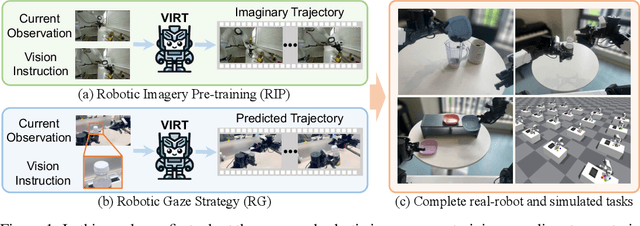

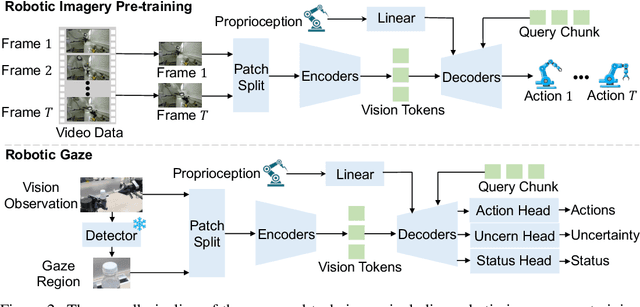
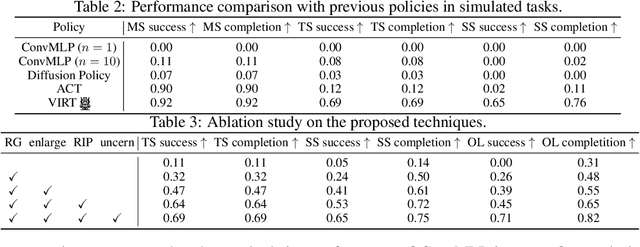
Abstract:Robotic manipulation, owing to its multi-modal nature, often faces significant training ambiguity, necessitating explicit instructions to clearly delineate the manipulation details in tasks. In this work, we highlight that vision instruction is naturally more comprehensible to recent robotic policies than the commonly adopted text instruction, as these policies are born with some vision understanding ability like human infants. Building on this premise and drawing inspiration from cognitive science, we introduce the robotic imagery paradigm, which realizes large-scale robotic data pre-training without text annotations. Additionally, we propose the robotic gaze strategy that emulates the human eye gaze mechanism, thereby guiding subsequent actions and focusing the attention of the policy on the manipulated object. Leveraging these innovations, we develop VIRT, a fully Transformer-based policy. We design comprehensive tasks using both a physical robot and simulated environments to assess the efficacy of VIRT. The results indicate that VIRT can complete very competitive tasks like ``opening the lid of a tightly sealed bottle'', and the proposed techniques boost the success rates of the baseline policy on diverse challenging tasks from nearly 0% to more than 65%.
TranSplat: Generalizable 3D Gaussian Splatting from Sparse Multi-View Images with Transformers
Aug 25, 2024



Abstract:Compared with previous 3D reconstruction methods like Nerf, recent Generalizable 3D Gaussian Splatting (G-3DGS) methods demonstrate impressive efficiency even in the sparse-view setting. However, the promising reconstruction performance of existing G-3DGS methods relies heavily on accurate multi-view feature matching, which is quite challenging. Especially for the scenes that have many non-overlapping areas between various views and contain numerous similar regions, the matching performance of existing methods is poor and the reconstruction precision is limited. To address this problem, we develop a strategy that utilizes a predicted depth confidence map to guide accurate local feature matching. In addition, we propose to utilize the knowledge of existing monocular depth estimation models as prior to boost the depth estimation precision in non-overlapping areas between views. Combining the proposed strategies, we present a novel G-3DGS method named TranSplat, which obtains the best performance on both the RealEstate10K and ACID benchmarks while maintaining competitive speed and presenting strong cross-dataset generalization ability. Our code, and demos will be available at: https://xingyoujun.github.io/transplat.
LARM: Large Auto-Regressive Model for Long-Horizon Embodied Intelligence
May 27, 2024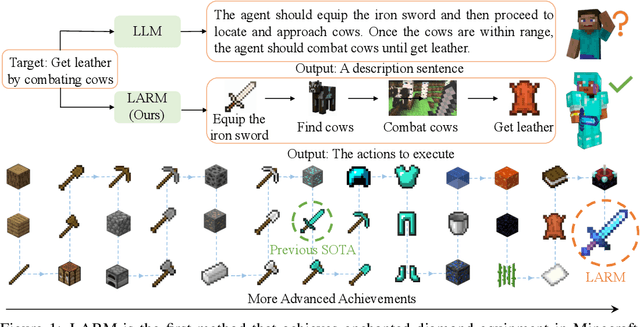
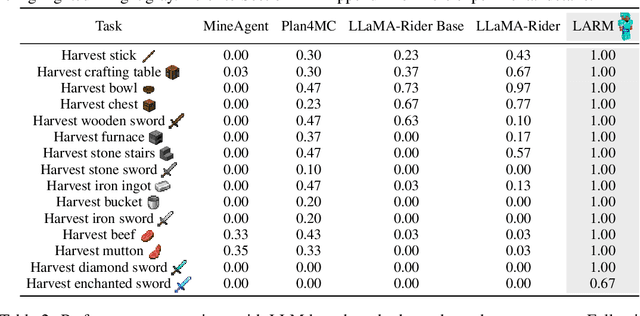
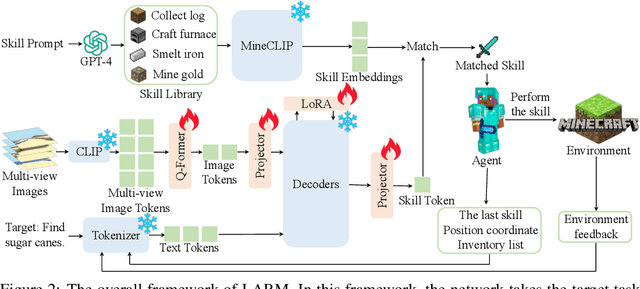

Abstract:Due to the need to interact with the real world, embodied agents are required to possess comprehensive prior knowledge, long-horizon planning capability, and a swift response speed. Despite recent large language model (LLM) based agents achieving promising performance, they still exhibit several limitations. For instance, the output of LLMs is a descriptive sentence, which is ambiguous when determining specific actions. To address these limitations, we introduce the large auto-regressive model (LARM). LARM leverages both text and multi-view images as input and predicts subsequent actions in an auto-regressive manner. To train LARM, we develop a novel data format named auto-regressive node transmission structure and assemble a corresponding dataset. Adopting a two-phase training regimen, LARM successfully harvests enchanted equipment in Minecraft, which demands significantly more complex decision-making chains than the highest achievements of prior best methods. Besides, the speed of LARM is 6.8x faster.
DisC-GS: Discontinuity-aware Gaussian Splatting
May 24, 2024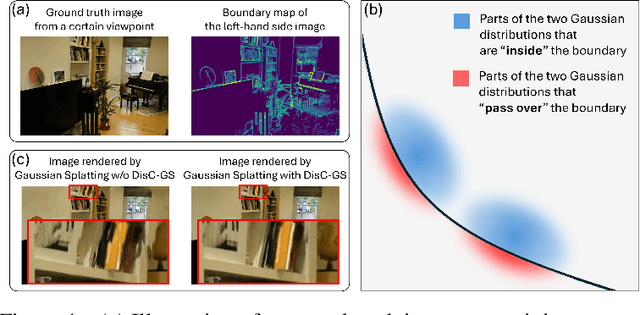


Abstract:Recently, Gaussian Splatting, a method that represents a 3D scene as a collection of Gaussian distributions, has gained significant attention in addressing the task of novel view synthesis. In this paper, we highlight a fundamental limitation of Gaussian Splatting: its inability to accurately render discontinuities and boundaries in images due to the continuous nature of Gaussian distributions. To address this issue, we propose a novel framework enabling Gaussian Splatting to perform discontinuity-aware image rendering. Additionally, we introduce a B\'ezier-boundary gradient approximation strategy within our framework to keep the ``differentiability'' of the proposed discontinuity-aware rendering process. Extensive experiments demonstrate the efficacy of our framework.
UniMODE: Unified Monocular 3D Object Detection
Feb 28, 2024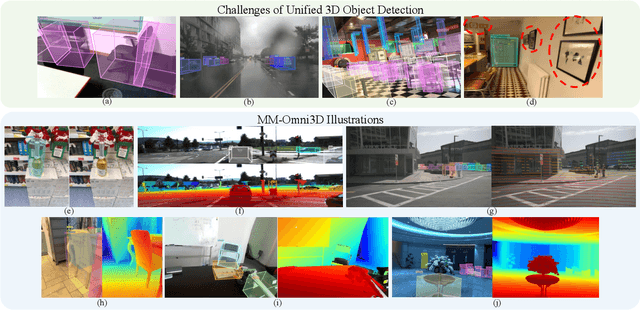
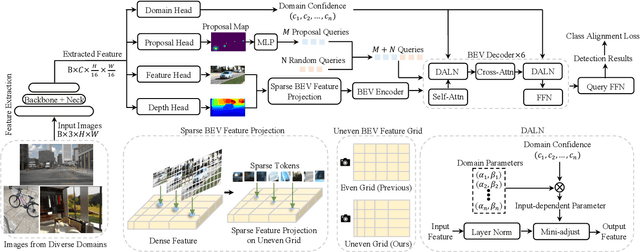
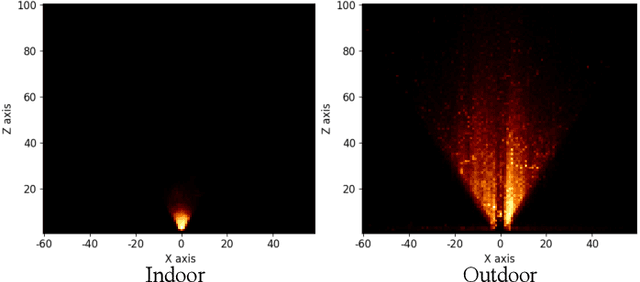
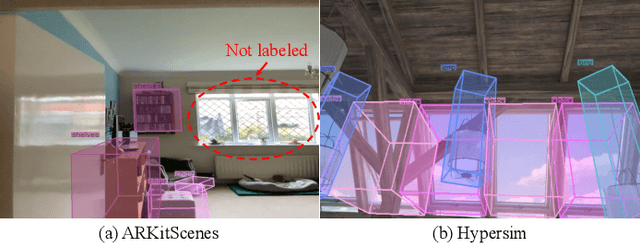
Abstract:Realizing unified monocular 3D object detection, including both indoor and outdoor scenes, holds great importance in applications like robot navigation. However, involving various scenarios of data to train models poses challenges due to their significantly different characteristics, e.g., diverse geometry properties and heterogeneous domain distributions. To address these challenges, we build a detector based on the bird's-eye-view (BEV) detection paradigm, where the explicit feature projection is beneficial to addressing the geometry learning ambiguity when employing multiple scenarios of data to train detectors. Then, we split the classical BEV detection architecture into two stages and propose an uneven BEV grid design to handle the convergence instability caused by the aforementioned challenges. Moreover, we develop a sparse BEV feature projection strategy to reduce computational cost and a unified domain alignment method to handle heterogeneous domains. Combining these techniques, a unified detector UniMODE is derived, which surpasses the previous state-of-the-art on the challenging Omni3D dataset (a large-scale dataset including both indoor and outdoor scenes) by 4.9% AP_3D, revealing the first successful generalization of a BEV detector to unified 3D object detection.
GroupLane: End-to-End 3D Lane Detection with Channel-wise Grouping
Jul 18, 2023Abstract:Efficiency is quite important for 3D lane detection due to practical deployment demand. In this work, we propose a simple, fast, and end-to-end detector that still maintains high detection precision. Specifically, we devise a set of fully convolutional heads based on row-wise classification. In contrast to previous counterparts, ours supports recognizing both vertical and horizontal lanes. Besides, our method is the first one to perform row-wise classification in bird-eye-view. In the heads, we split feature into multiple groups and every group of feature corresponds to a lane instance. During training, the predictions are associated with lane labels using the proposed single-win one-to-one matching to compute loss, and no post-processing operation is demanded for inference. In this way, our proposed fully convolutional detector, GroupLane, realizes end-to-end detection like DETR. Evaluated on 3 real world 3D lane benchmarks, OpenLane, Once-3DLanes, and OpenLane-Huawei, GroupLane adopting ConvNext-Base as the backbone outperforms the published state-of-the-art PersFormer by 13.6% F1 score in the OpenLane validation set. Besides, GroupLane with ResNet18 still surpasses PersFormer by 4.9% F1 score, while the inference speed is nearly 7x faster and the FLOPs is only 13.3% of it.
The 1st-place Solution for CVPR 2023 OpenLane Topology in Autonomous Driving Challenge
Jun 16, 2023Abstract:We present the 1st-place solution of OpenLane Topology in Autonomous Driving Challenge. Considering that topology reasoning is based on centerline detection and traffic element detection, we develop a multi-stage framework for high performance. Specifically, the centerline is detected by the powerful PETRv2 detector and the popular YOLOv8 is employed to detect the traffic elements. Further, we design a simple yet effective MLP-based head for topology prediction. Our method achieves 55\% OLS on the OpenLaneV2 test set, surpassing the 2nd solution by 8 points.
 Add to Chrome
Add to Chrome Add to Firefox
Add to Firefox Add to Edge
Add to Edge